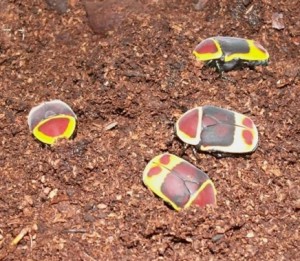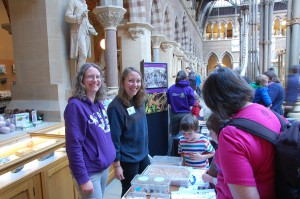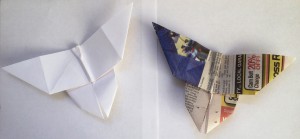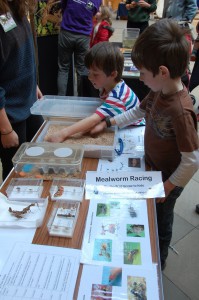
February feels like a lifetime away now, I really didn’t think that you could pack in so much in such a short space of time. I am, very obviously, not alone in this – the other Trainees have also been extolling the virtues of a busy schedule!
At the end of February, I met with Moya Burns, one of the first ever Natural Talent bods. Moya also took up the saproxylic cause in Scotland and it was great to have the benefit of her knowledge whilst on a walk around Wytham Woods. She has co-developed the Saproxylic Activity Index which is a tool used to quantify the density and diversity of saproxylic insects in deadwood by using exit bore holes. The paper is p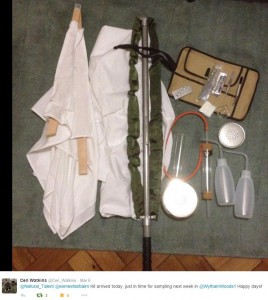 ublished in an open access journal and is available here.
ublished in an open access journal and is available here.
The following week, a large package arrived and it caused much excitement! A happy hour was spent investigating the contents that evening –entomological equipment of all shapes and uses. In a future blog, we can look at how to use some of this kit. Many thanks go to Esmee Fairbairn for this wonderful box of goodies.
As Liam and Anna have so eloquently written about the week we all spent together at the Oxford University Museum Natural History, I will not linger long there. Only to add a big thank you to Sally-Ann Spence from Minibeast Mayhem for the wonderful evening of entertainment at her family’s farm. Sally-Ann is an outreach educator extraordinaire that takes her roadshow of invertebrates to schools and events across Oxfordshire, Wiltshire and Berkshire. It was an evening stuffed full of invertebrate tips, with everything from how to help a young child handle an insect with safety for both in mind (after all who wants their prized locust or mantis squashed!) to rearing your own Pachnoda “sun beetles”. Check out more about the great work she does here.
The middle of March every year sees the Wow? How! event at the Museum. This is a full on, hands on day of science exploration where everyone can take part in experiments and other activities. It is part of Oxfordshire Science Festival and British Science Week and targeted at children of 8+ but in all honesty there were people of all ages in abundance. There is usually around 3500 visitors and this year was no exception. I opted to run an Insect Defences stall with lots of information on all the great and ingenious ways that insects keep themselves safe from predation. You may realise that some insect feign death (thanatosis) in the face of attack but did you know that a fly’s eyes send updates to their brain around seven times faster than our own? This means that when we try to catch them, our actions might appear in something like slow motion. Flies also evade by rolling their bodies in a flight movement similar to an aeroplane banking. Perhaps this was the inspiration for the scenes of Keanu Reeves dodging bullets in the Matrix??
On the activities side of things, there was moth origami with plain white paper and newspaper to demonstrate camouflage and the story of the peppered moth, Biston betularia (click here to find out more). If you would like to have a go, the origami instructions are found here.
The giant mealworm racing was a hit with kids of all ages. Mealworms (Tenebrio molitor) are actually beetle larvae and they quickly bury themselves to hide due to phototaxis (moving away from light). Interestingly, the “real” kids were nowhere near as fazed as the “big” kids when picking up these innocuous insects. Just goes to show how as adults we need to be aware of how easily we can pass on our phobias to the next generation. Many thanks go to Katy, Shelly and Chiara for helping out on the day and keeping enthusiastic throughout even when surrounded for the umpteenth time.
Another project underway, is the development of an iRecord page for Wytham Woods. iRecord is a website that supports online collection and collation of high quality biological recording data. It is a fantastic resource that feeds into the National Biodiversity Network (NBN Gateway), so this is going to be very exciting once it is up and running.
I have learnt so much already and this blog post is really the tip of the March iceberg. For the month in general focus has been outreach and public engagement and it has been a massively fun time. I am now also better able to find my way around the layout of the Entomological Collections (this is done in a very specific way) and I am beginning to recognise the different characteristics of the beetle families and can key them out much more quickly. I have also began collecting immature insects in the woods in order to rear them through to adulthood. For deadwood species this can be quite difficult as maintaining the correct moisture levels can be challenging. The aim here is to be able to identify immatures when they reach adulthood. Identifying larvae to species level can be almost impossible as only a handful of species have unique characteristics that enable this. Identification to family level is more achievable but can still be difficult too.
That’s all for now folks, catch you again soon. Ceri

